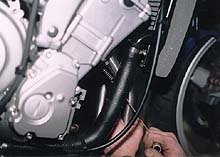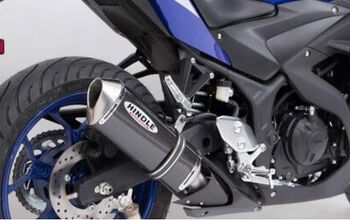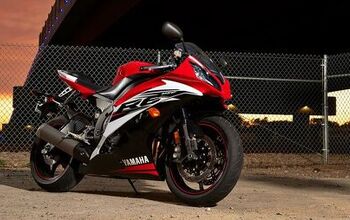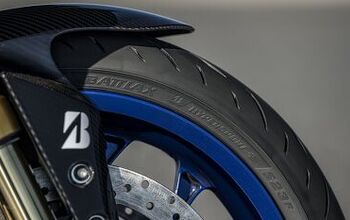The GMS Exhaust System for the Yamaha YZF-R6
For some reason, certain sportbike folks just absolutely have to buy new exhaust pipes for their bikes. You can see (and often hear) they coming a mile away. The thought process might go something like this: Hmm, like bike, bike is good, ahh, stock pipe heavy, ugly, must do something, need more power, gotta look cool, what to do? Buy new exhaust! Yes! More air. Less filling. Taste great. Still got credit left on Amex. Buy. Buy. Buy. That, dear readers, is what is called a pipe dream.
Since the R6 will inevitably be a bike with a huge selection of aftermarket goodies that can be bolted onto it, we figured we'd get a head start by slapping on a Graves Motorsports pipe on our test unit. We took our little blue demon over to Graves Motorsports where Chuck Graves had prepared what must certainly be one of the first aftermarket pipes for the little race-bred Yamaha. We wanted to do back to back dyno runs with stock exhaust and the new GMS pipe to see if a pipe would free up some additional ponies.
Stainless steel spigots are included that bolt onto the motor, fitting inside the exhaust manifold. The canister features straight through plumbing with an improved baffling surrounding the perforated through-pipe. A slotted clamp holds the canister onto the exhaust bracket sprouting from the rear right passenger peg. This clamp is a design improvement, since the old solid band clamps were prone to sometimes break.
So, what was the verdict? What did the tale of the dyno reveal?
Check out the dyno chart. In stock form the bike runs lean, but still cranked out a maximum (corrected) 95.0 horsepower and 42.7 foot pounds of torque. Post GMS pipe installment, the bike pumped out 99.4 horsepower and 43.4 foot pounds of torque, a healthy improvement of 4.4 horsepower. It is certain that a well engineered exhaust will free up some extra power when it is installed on the R6. Make a note. Keep in mind however, this test was conducted with a pre-production R6, a pre-production exhaust pipe (sans GMS nameplate even), and different fuel was used on the baseline run. After whipping the R6 through a number of
So there you have it. Maybe those aftermarket hounds are onto something after all. Perhaps we should all be chasing a pipe dream. We'll take ours in carbon fiber.
Graves Motorsports may be contacted at (818) 902-1942.
Chuck Graves putting the R6 through its paces on the dyno. The fan system in front of the bike blows air to keep the cooling system functional. The smaller fan on top is designed to blow air into the ram air ducts. While it does offer some positive pressure, it is very limited, so probably doesn't account for any significant horsepower gains. Put a dyno in an actual hurricane though, and then you might see some benefit.
More by Kerry Ward































Comments
Join the conversation